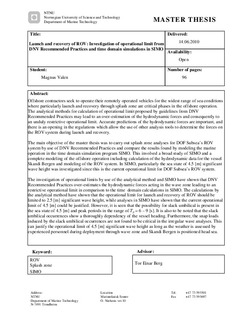| dc.contributor.author | Valen, Magnus | nb_NO |
| dc.date.accessioned | 2014-12-19T12:06:12Z | |
| dc.date.available | 2014-12-19T12:06:12Z | |
| dc.date.created | 2010-12-08 | nb_NO |
| dc.date.issued | 2010 | nb_NO |
| dc.identifier | 375590 | nb_NO |
| dc.identifier.uri | http://hdl.handle.net/11250/237839 | |
| dc.description.abstract | Offshore contractors seek to operate their remotely operated vehicles for the widest range of sea conditions where particularly launch and recovery through splash zone are critical phases in the offshore operation. The analytical methods for calculation of operational limit proposed by guidelines from DNV Recommended Practices may lead to an over-estimation of the hydrodynamic forces and consequently to an unduly restrictive operational limit. Accurate predictions of the hydrodynamic forces are important, and there is an opening in the regulations which allow the use of other analysis tools to determine the forces on the ROV system during launch and recovery.
The main objective of the master thesis was to carry out splash zone analyses for DOF Subsea’s ROV system by use of DNV Recommended Practices and compare the results found by modeling the marine operation in the time domain simulation program SIMO. This involved a broad study of SIMO and a complete modeling of the offshore operation including calculation of the hydrodynamic data for the vessel Skandi Bergen and modeling of the ROV system. In SIMO, particularly the sea state of 4.5 [m] significant wave height was investigated since this is the current operational limit for DOF Subsea’s ROV system.
The investigation of operational limits by use of the analytical method and SIMO have shown that DNV Recommended Practices over-estimates the hydrodynamic forces acting in the wave zone leading to an restrictive operational limit in comparison to the time domain calculations in SIMO. The calculations by the analytical method have shown that the operational limit for launch and recovery of ROV should be limited to 2.5 [m] significant wave height, while analyses in SIMO have shown that the current operational limit of 4.5 [m] could be justified. However, it is seen that the possibility for slack umbilical is present in the sea state of 4.5 [m] and peak periods in the range of Tp = 6 – 9 [s]. It is also to be noted that the slack umbilical occurrences show a thoroughly dependency of the vessel heading. Furthermore, the snap loads induced by the slack umbilical occurrences are not found to be critical in the irregular wave analyses. This can justify the operational limit of 4.5 [m] significant wave height as long as the weather is assessed by experienced personnel during deployment through wave zone and Skandi Bergen is positioned head sea. | nb_NO |
| dc.language | eng | nb_NO |
| dc.publisher | Norges teknisk-naturvitenskapelige universitet, Fakultet for ingeniørvitenskap og teknologi, Institutt for marin teknikk | nb_NO |
| dc.title | Launch and recovery of ROV: Investigation of operational limit from DNV Recommended Practices and time domain simulations in SIMO | nb_NO |
| dc.type | Master thesis | nb_NO |
| dc.contributor.department | Norges teknisk-naturvitenskapelige universitet, Fakultet for ingeniørvitenskap og teknologi, Institutt for marin teknikk | nb_NO |
